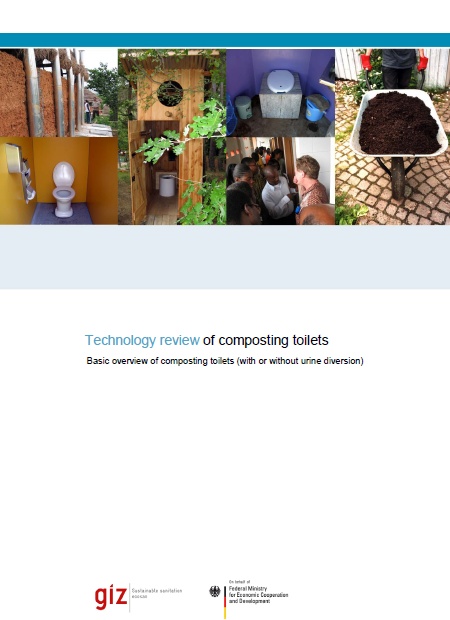Technology review of composting toilets - Basic overview of composting toilets (with or without urine diversion)
Berger, W. (2011)

Published in: 2011
Publisher:
Deutsche Gesellschaft für Internationale Zusammenarbeit (GIZ) GmbH, Eschborn, Germany
Author:
Berger, W.
Uploaded by:
SuSanA secretariat
Partner profile:
Deutsche Gesellschaft für Internationale Zusammenarbeit (GIZ) GmbH
17853 Views
1337 Downloads
Content - Summary
Composting toilets are dry toilets which operate without the need for flushing water. They can be used independently of connections to sewers and provide a safe and hygienic sanitation alternative for a range of possible applications. Composting toilets can considerably reduce household water consumption and the costs for wastewater treatment.
This publication explains the design and use of composting toilets which are either manufactured or owner-built. It also briefly describes external composting in a unit which is separate from the toilets (usually located in the garden).
Composting toilets have sometimes also been termed “eco-toilets”. They should not be confused with urine diversion dehydration toilets (UDDTs). In the latter type of toilet, only drying takes place but no biological composting activities occur.
A composting toilets consists of two basic elements: a place to sit or squat and a collecting or composting device. Additionally a ventilation system allows for good aeration of the composting vault, removal of excess moisture and reduces odour. The emptying frequency of the composting vault depends on the capacity of the container, the feeding rate and the composting conditions.
Composting toilets can be designed with or without diversion of urine; urine diversion simplifies the management of the leachate and can be implemented if there is a demand for urine as a fertiliser.
This publication explains the functional principles of composting toilets such as the biological process, bulking material, ventilation, pathogen removal (hygienisation), optimum water content, management and reuse of leachate and compost.
The publication also gives an overview of the operational requirements for composting toilets. Regular maintenance of composting toilets in private or public use is critical to ensure that the facility is operating well. This involves proper cleaning, controlling of technical componets of the facilities and the composting process as well as safe treatment, handling and application of faecal compost and leachate (and urine if it is collected separately).
The main four types of composting toilets are explained in detail:
• Single-vault composting toilets
• Multiple-vault composting toilets
• Mobile bucket or bin toilets followed by composting of the excreta
• Composting toilets with mechanical devices
Ample examples for composting toilets from around the world are included in the publication to show that these types of toilets have a wide range of applications under a variety of circumstances (for wealthy or poor people; for cold, hot, wet or dry climates; for urban or rural settings).
With this publication we aim to make composting toilets more widely known worldwide and to make their potential for providing sustainable sanitation clearer for all those who make decisions on future sanitation systems.
Bibliographic information
Berger, W. (2011). Technology review of composting toilets - Basic overview of composting toilets (with or without urine diversion). Deutsche Gesellschaft für Internationale Zusammenarbeit (GIZ) GmbH, Eschborn, Germany
Filter tags
Composting, vermicomposting (solid waste), composting toilets English Practitioners Recommended by SuSanA (other than SuSanA publications)















